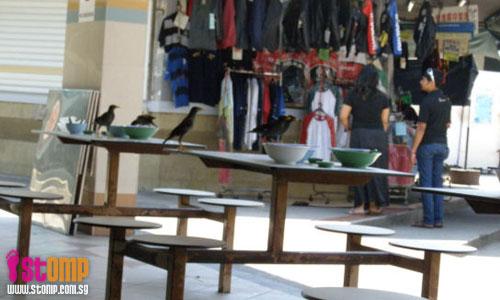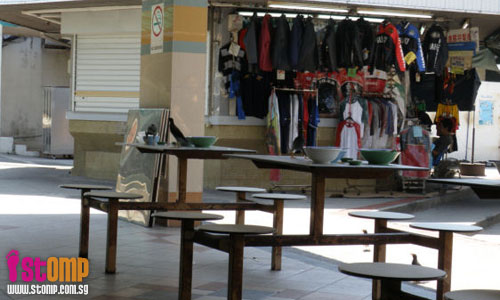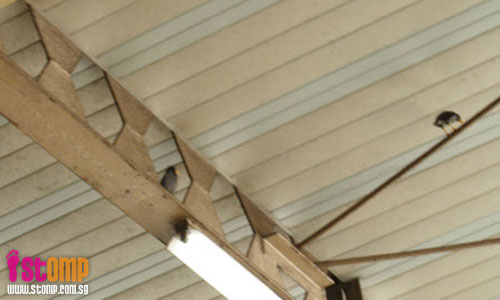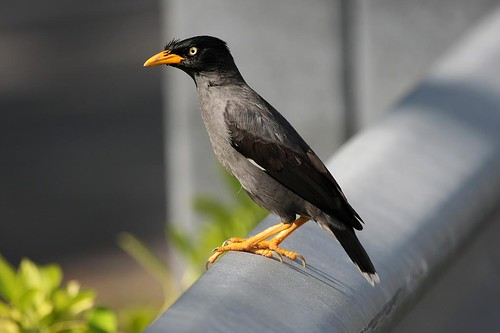
STOMPer Food Lover was disgusted when a myna perched on the beam above him excreted bird droppings right into his kway teow soup. The STOMPer elaborates:
"These pictures were taken at the food centre at Alexandra Village at Jalan Bukit Merah.
"The NEA has built this food centre with many horizontal bars where the birds can rest.
"You can see the white-vented myna perching on the ceiling bars.
"When I was eating my kway teow soup, suddenly these birds decided to release their daily 'bombs' and one of them landed inside by bowl of kuay teow soup.
"My lunch was a great disappointment but my colleague advised me to go to the nearby shop to buy a 4D lottery ticket.
"I was too disappointed to queue up for a ticket.
"When the diners leave, the birds have a field day. They swoop down like hungry vultures and help themselves to the food remnants.
"After this invasion, you can see bird droppings on the table, stools and the floor.
"These birds are a public nuisance and it is time the NEA get rid of these pests.
"Also, hawker centres and food centres should not be built such that birds have a place to perch above the tables where the diners are sitting."



Related posts: How unhygienic! Pigeons feast on leftover food at Bendemeer Market (12th April 2009)
"No avian flu here but this bird can spread other diseases" (6th March 2009)
Crazy pigeon is not afraid of people and steals food from their plates (23rd January 2009)
Note: The Javan myna (Acridotheres javanicus) we commonly see here in Singapore was once thought to belong to the same species as the white-vented myna (Acridotheres grandis), which is a different species altogether and not found in Singapore at all. However, one does still find the name white-vented myna being used for the Javan myna.

Javan myna, Singapore;
(Photo by mjmyap)

White-vented myna, Bangkok;
(Photo by mmp86)
Well, that really is an unfortunate way to have one's meal ruined by the birds. When I was in junior college, I had once ordered a plate of chicken rice in the school canteen, and left it there on the table while I went to get a drink. When I returned, someone at another table informed me that the sparrows had started feeding on my lunch while I was away. I probably should have thrown my food away and ordered a new plate, but I was silly and short of cash then, and I reasoned that if the birds were willing to eat the food, it meant that the food being sold in the canteen wasn't too bad. So I just carried out on eating, oblivious to any possible health risks.
On the other hand, what does it say about the food being sold at the establishment in this post? That it's so bad that birds poop in it? I kid, of course.
Yet another post on the unwelcome presence of urban birds. Birds like the Javan myna, common myna (Acridotheres tristis), house crow (Corvus splendens), Eurasian tree sparrow (Passer montanus), and feral pigeon (Columba livia) are so widespread and prevalent that I sometimes wonder if people ever notice the other birds that can be commonly seen in urban Singapore, such as the olive-backed sunbird (Cinnyris jugularis), Asian glossy starling (Aplonis panayensis), yellow-vented bulbul (Pycnonotus goiavier), common tailorbird (Orthotomus sutorius), black-naped oriole (Oriolus chinensis), Pacific swallow (Hirundo tahitica), Sunda pygmy woodpecker (Dendrocopos moluccensis), collared kingfisher (Todiramphus chloris), spotted dove (Streptopelia chinensis), or pink-necked green pigeon (Treron vernans).
This is one reason why I strongly support getting people to clear up after themselves. If people had the initiative to bring their trays and utensils to clearing points, it would reduce the amount of food available for the birds, as the birds would have less time to swoop in and grab a morsel. Ideally, this should eventually lead to a decrease in the number of birds seen hanging around food centres, as they look for easier pickings elsewhere.
These birds are only exploiting a niche available to them, and we ourselves are all too willing to provide them with the resources for them to survive and prosper. Once again, it's all about changing human attitudes and behaviour. One doesn't always have to resort to culling and shooting and poisoning in order to manage our relationship with other animals. What sort of attitude does that convey? That killing is an acceptable initial response to any problem in which animals and humans come into some sort of conflict? I'm no hippie, and I do accept that killing is sometimes necessary in order to manage populations of other species, but I believe that there are always other viable methods that ought to be explored first before we reach for the poison and guns.
I'm sure there are far more human solutions than the one that has been adopted in this video below:
Even when culling is necessary in order to bring the population down to more manageable levels, it is important that preventive measures are taken so as to ensure that the bird populations don't rebound. In some cases, after culling, the survivors find that there is less competition over resources such as food and nesting sites, and are able to breed more often and with higher survival of the young, thus completely negating the intended effects of the culling. Culling should always take place in conjunction with efforts to limit access to resources. You can shoot or poison as many birds as you want, but as long as there is food available, and places for the birds to roost and nest, then the birds will just keep on breeding.
In a case such as the food centre pictured in this post, if culling is seen as a necessary measure, then it should be held in conjunction as part of a comprehensive plan to control the growth of bird populations.
Access to food should be limited by making sure that proper rubbish disposal practices are adhered to, and by making sure that leftovers are cleared promptly before the birds get a chance to swoop in. Littering creates scavenging opportunities for birds, and should be curbed. One also has to ensure that consistency is adhered to within the entire neighbourhood; a single business or residence that doesn't comply may cause the problem to persist. For example, well-meaning but misguided residents who insist on feeding the birds may artificially sustain high populations even as they are being deprived of sources of food elsewhere.
Steps should be taken to humanely exclude and repel birds from food centres. Bird spikes, chemical repellents, predator decoys, recording of alarm calls, and even ultrasonic repellents are all available in the market, with varying degrees of success in real-life situations.
Another very important measure is to reduce the availability of breeding and roosting sites. This means sealing any gaps in buildings which may be used as nest sites, using devices like those mentioned above to prevent them from roosting in buildings, or even a simple matter of pruning the trees. Removal or destruction of nests with eggs and young can be an effective measure to reduce the population, but it should probably only be carried out in combination with measures to reduce the likelihood of the birds breeding there again.
Trapping and relocating birds may not necessarily be a feasible option in small, densely-populated Singapore, and only means that you're transferring the problem to somebody else. Releasing non-native bird species in nature areas isn't a very good idea because of the possible threat to native ecosystems. Also, the birds, once relocated, may be disorientated and face difficulties in adapting to a sudden change in environment, or may simply take off and fly back to where they were caught. Here in Singapore, it may be more feasible to humanely euthanise the birds that are trapped. This site here discusses various means to dispose of house sparrows (Passer domesticus), a non-native species in North America and one that often negatively impacts the reproductive success of native songbirds.
In most cases, if culling is carried out along with a host of other measures to control the factors which allow the population to increase in the first place, one should eventually notice an appreciable decrease in bird numbers, and consequently reduce the conflict between humans and birds. I'm not sure how far culling alone has contributed to the reduction in house crow numbers in Singapore, but I'm sure that it was not the only contributing factor. It would be foolhardy to assume that the population was reduced solely by blasting them out of the sky at intervals, and I wonder if someone is looking into the various factors that have led to this decrease in the population.
It doesn't take a genius to figure out that this multi-pronged approach to controlling birds can and should be adapted in the control of other pests, whether be it rodents or insects. Similarly, just as how shooting crows only serves to kill the birds without doing anything about the reasons behind the growth in their population, setting glue traps (which are extremly cruel in my opinion) and poison bait for rats does nothing to combat the underlying causes that led to the problem in the first place. And often, that means educating people in the need to prevent these problems from occurring at all.
It is usually impossible to completely eliminate cockroaches, rats or crows from an area; the only viable solution is to manage their numbers and ensure that their populations do not explode. Proper storage of food and waste disposal and clamping down on littering are necessary measures to prevent these opportunists from taking advantage of our negligence and laziness. We can call for the authorities to get rid of these so-called pests as much as we want, but ultimately, if we are to truly manage the populations of these adaptable species, then the main thing that we have to manage is our own behaviour.